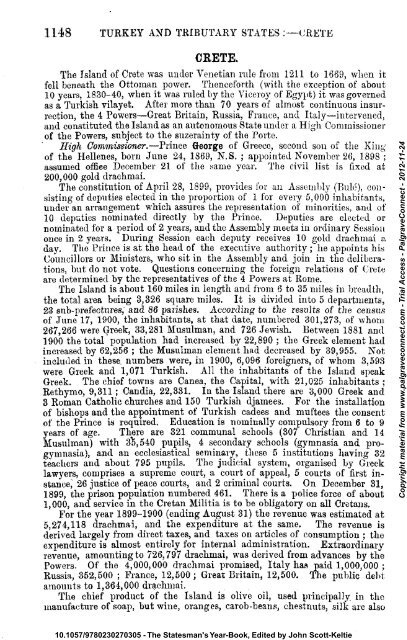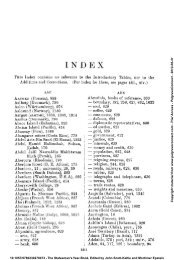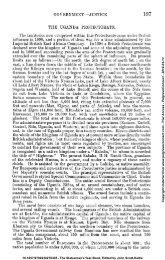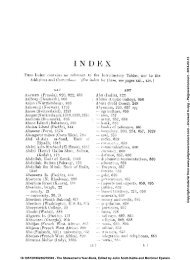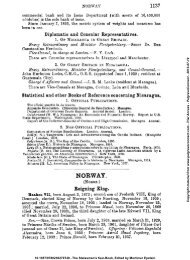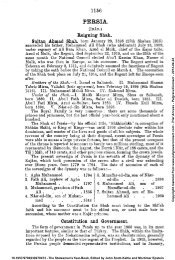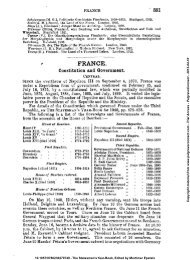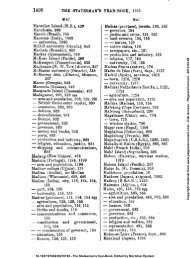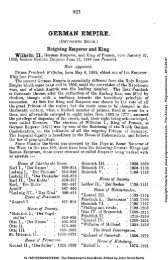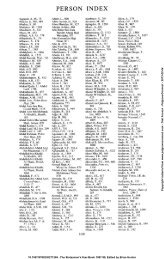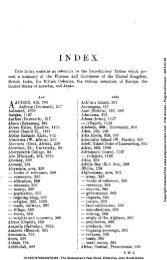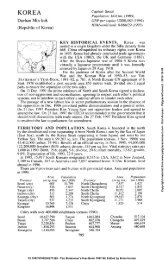Bulgaria - Palgrave Connect
Bulgaria - Palgrave Connect
Bulgaria - Palgrave Connect
Create successful ePaper yourself
Turn your PDF publications into a flip-book with our unique Google optimized e-Paper software.
1148 TURKEY AND TRIBUTARY STATES :—CRETE<br />
CKETE.<br />
The Island of Crete was under Venetian rule from 1211 to 1669, when it<br />
fell beneath the Ottoman power. Thenceforth (with the exception of about<br />
10 years, 1830-40, when it was ruled by the Viceroy of Egypt) it was governed<br />
as a Turkish vilayet. After more than 70 years of almost continuous insurrection,<br />
the 4 Powers—Great Britain, Russia, France, and Italy—intervened,<br />
and constituted the Island as an autonomous State under a High Commissioner<br />
of the Powers, subject to the suzerainty of the forte.<br />
High Commissioner.—Prince George of Greece, second son of the King<br />
of the Hellenes, born June 24, 1869, N.S. ; appointed November 26, 1898 ;<br />
assumed offiee December 21 of the same year. The civil list is fixed at<br />
200,000 gold drachmai.<br />
The constitution of April 28, 1899, provides for an Assembly (Bulo), consisting<br />
of deputies elected in the proportion of 1 for every 5,000 inhabitants,<br />
under an arrangement which assures the representation of minorities, and of<br />
10 deputies nominated directly by the Prince. Deputies are elected or<br />
nominated for a period of 2 years, and the Assembly meets in ordinary Session<br />
once in 2 years. During Session each deputy receives 10 gold drachmai a<br />
day. The Prince is at the head of the executive authority ; he appoints his<br />
Councillors or Ministers, who sit in the Assembly and join in the deliberations,<br />
but do not vote. Questions concerning the foreign relations of Crete<br />
are determined by the representatives of the 4 Powers at Rome.<br />
The Island is about 160 miles in length and from 6 to 35 miles in breadth,<br />
the total area being 3,326 square miles. It is divided into 5 departments,<br />
23 sub-prefectures, and 86 parishes. According to the results of the census<br />
of June 17, 1900, the inhabitants, at that date, numbered 301,273, of whom<br />
267,266 were Greek, 33,281 Musulman, and 726 Jewish. Between 1881 and<br />
1900 the total population had increased by 22,890 ; the Greek element had<br />
increased by 62,256 ; the Musulman element had decreased by 39,955. Not<br />
included in these, numbers were, in 1900, 6,096 foreigners, of whom 3,593<br />
were Greek and 1,071 Turkish. All the inhabitants of the Island speak<br />
Greek. The chief towns are Canea, the Capital, with 21,025 inhabitants ;<br />
Rethymo, 9,311 ; Candia, 22,331. In the Island there are 3,000 Greek and<br />
3 Roman Catholic churches and 150 Turkish djamees. For the installation<br />
of bishops and the appointment of Turkish cadees and muftees the consent<br />
of the Prince is required. Education is nominally compulsory from 6 to 9<br />
years of age. There are 321 communal schools (307 Christian and 14<br />
Musulman) with 3^,540 pupils, 4 secondary schools (gymnasia and progymnasia),<br />
and an ecclesiastical seminary, these 5 institutions having 32<br />
teachers and about 795 pupils. The judicial system, organised by Greek<br />
lawyers, comprises a supreme court, a court of appeal, 5 courts of first instance,<br />
26 justice of peace courts, and 2 criminal courts. On December 31,<br />
1899, the prison population numbered 461. There is a police force of about<br />
1,000, and service in the Cretan Militia is to be obligatory on all Cretans.<br />
For the year 1899-1900 (ending August 31) the revenue was estimated at<br />
5,274,118 drachmai, and the expenditure at the same. The revenue is<br />
derived largely from direct taxes, and taxes on articles of consumption ; the<br />
expenditure is almost entirely for internal administration. Extraordinary<br />
revenue, amounting to 726,797 drachmai, was derived from advances by the<br />
Towers. Of the 4,000,000 drachmai promised, Italy has paid 1,000,000 ;<br />
Russia, 352,500 ; France, 12,500; Great Britain, 12,500. The public debt<br />
amounts to 1,364,000 drachmai.<br />
The chief product of the Island is olive oil, used principally, in the<br />
manufacture of soap, but wine, oranges, carob-beans, chestnuts, silk are also<br />
10.1057/9780230270305 - The Statesman's Year-Book, Edited by John Scott-Keltie<br />
Copyright material from www.palgraveconnect.com - Trial Access - <strong>Palgrave</strong><strong>Connect</strong> - 2012-11-24


